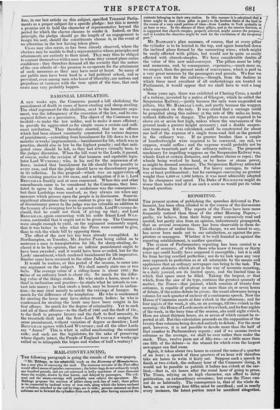- - MAIL-CONVEYANCINR I " IRE following paragraph is going the rounds
of the newspapers.
Babbage;- in 4ris-admir-abre-Work on the Economy of Manufactures, has a new plan of conveying the mail. The immense revenue of the Post-office would afford means of speedier conveyance; the letter-bags do not ordinarily weigh one hundred pounds, and are yet conveyed in bulky machines of some thousand times the weight, drawn by four horses, and delayed by passengers. The rpil- road and the steam-carriage will probably soon relieve the speculator. Mr. Babbage proposes' the erection of pillars along each line of road; these pillars to be connected by inclined wires or iron rods, along which the letters enclosed in cylinders, attached to the rod by rings, are to slide; persons stationed on these columns are to forward the cylinders from each point; after having extracted the
k
contents belonging to their own station. In this manner it is calculated dual letter might be sent (from pillar to post) to the farthest limits Of the land in the course of a very small portion of time—from London to York probably in 1 an hour or two. In the absence of these pillars, and in the interior districts, it is suggested that church-steeples,- properly selected, might answer the purpose; and in London the churches might be used for the circulation of the twopenny , post."
Mr. BABBAGE'S plan assumes, of course, that at every pillar the cylinder is to be hoisted to the top, and again launched down the inclined plane formed by the connecting wires; which might be easily effected with pillars, but would not be quite so easily effected with church-steeples. We have considerable doubts of the value of' this new mail-conveyer. The pillars must be lofty and numerous, and, by consequence, expensive,—much more so, we suspect, than the present mode of conveyance, which is paid in a very great measure by the passengers and parcels. We fear we must e'en wait for the railways,—though, from the fashion in which these most excellent of all undertakings are treated in Parliament, it would appear that we shall have to wait a long while.
Some years ago, there was exhibited at Charing Cross, a model of a railway, invented by a native of Glasgow, which he called the Suspension Railway,—partly because the rails were suspended on pillars, like Mr. BABBAGE'S rods, and partly because the waggon was suspended on the rails. It was stated that a carriage could be propelled along this railway at the rate of fifty miles an hour, without difficulty or danger. The pillars were not required to be above six or seven feet high, unless where the unevenness of the ground made a greater height necessary ; and a double suspen- sion tram-road, it was calculated, could be constructed for about one half of the expense of a single tram-road laid on the ground in the ordinary way. If no greater burden than a couple of hundredweight were required to be conveyed, one rail, we suppose, would suffice ; and the expense would probably not be above one twentieth part of the ordinary railway. The proposed machinery for impelling waggons on the Suspension Railway was, wheels fixed at certain distances, and endless chains or ropes; the wheels being worked by hand, or by horse or steam power, as might be deemed necessary. The Suspension Railway attracted less attention than it deserved. For heavy carriages, its value was at least problematical ; but for carriages conveying no greater weight than 4,000 or 5,000 letters, it was most admirably adapted by its cheapness and speed. The Duke of RICHMOND might do worse than make trial of it on such a scale as would put its value beyond question.



























 Previous page
Previous page